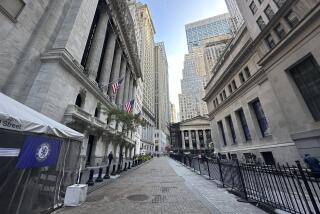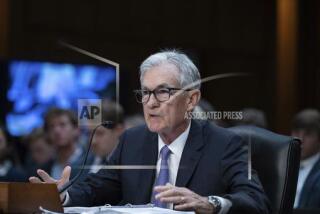Fed Bashing Raises Risks of Inflation
JACKSON HOLE, Wyo. â The 1980s have been a vintage decade for the Federal Reserve, the nationâs chief inflation fighter.
Only 10 years ago, with prices rising at alarming double-digit rates and the value of the dollar collapsing, the central bank had lost all credibility and was forced to engineer the worst recession since the end of World War II to bring the inflationary spiral to a halt.
Since the end of the downturn in late 1982, though, the U.S. economy has behaved like a fine wine that just keeps getting better with age. The nation has enjoyed almost seven years of uninterrupted economic growth, largely without the customary run-up in inflation. Much of the credit has landed on the Fed.
But this is a wine that could quickly turn to vinegar. As the economy moves toward fuller use of its labor, factories and other resources, the Fed no longer enjoys much room for error. At the same time, the Bush Administration appears to be setting up the central bank for blame in any future recession, suggesting that the strong political support that the Fed has received for its anti-inflation stance is on the wane.
âThe road ahead may turn out to be a virtual mine field,â Lyle Gramley, a former Fed governor, told a recent gathering here of academic experts and central bankers from around the world. Although Fed officials know from the bitter experience of the 1970s that very low inflation is necessary to ensure sustained economic growth, âthe politicians may not have learned the same lessons,â Gramley said.
Fed officials still hope to bring inflation down close to zero, but politicians happily tolerate todayâs rate of inflation--about 5% a year--if the only cure is a recession. For the present, the Fed tacitly acknowledges that it is unlikely to improve on todayâs inflation rate, a posture that will avert a confrontation only as long as price pressures do not mount.
âThe best you can expect is a capping of inflation at current levels,â acknowledged Roger Guffey, president of the Kansas City Federal Reserve Bank, which sponsored the Jackson Hole conference on monetary policy.
To Guffey, that means that the Fed should probably aim at keeping interest rates high enough to slow the economy to a very modest growth rate of less than 2% through at least the end of next year. Under such a scenario, inflationary pressures might ease, but slow growth and rising unemployment could set off a political backlash.
Fed Officials Baffled
âIâm afraid we may be expecting too much,â Guffey acknowledged. âPolitical pressures could build to the boiling point.â
The Fed is already feeling the heat.
Last month, White House budget director Richard G. Darman set off a new campaign of public Fed bashing by the Bush Administration. âIf we do have a recession,â he argued in a television interview, âI think it will be because they erred on the side of caution.â
President Bush later endorsed Darmanâs statement, calling it âvery balanced.â
The White Houseâs chief economist, however, was more modest in his comments on the Fed last Thursday. While not attacking the Fed directly, Michael J. Boskin urged monetary officials to aim for stronger growth. âWe would not be satisfied with a definition of soft landing that merely avoids a recession,â Boskin said.
Fed officials, accustomed as they are to taking the political blame for economic downturns, are baffled by the recent wave of Administration attacks.
âThe Fed managed to nip in the bud a flowering inflation in 1988 and turn the corner to an easier monetary policy early enough in 1989 to avoid a recession,â Gramley said. âThat is a remarkably good performance. But itâs not good enough for the Administration.â
Many economists see a danger that the brewing conflict may backfire on the White House, pushing up interest rates in the bond market by raising doubts among investors about the ability of the Fed to resist political pressures for easier money.
Strong-Arming Criticized
In this view, investors realize that easy money will breed inflation--and therefore higher interest rates--later. Anticipating those higher rates in the future, investors bid up rates in the present.
David Hale, chief economist of Kemper Financial Services of Chicago, is particularly critical of Darman for strong-arming the Fed. In a recent newsletter, Hale turned a widely publicized Darman speech against him.
In a July speech, Darman complained that Americans consume too much and save too little. He likened Americans to the child in the 1950s commercial who screamed: âI want my Maypo! I want it NOW!â
Hale wrote: âIn an unintended self-parody. . ., Darman made it clear that he wants lower interest rates and, like the child in the Maypo ad of the 1950s, he wants them NOWWWW! In fact, a Maypo-style Federal Reserve policy geared to instant monetary gratification could be counterproductive for the Administration by triggering a resurgence of bond market vigilantism.â
Pressure from the White House to avoid an economic slowdown even at the risk of higher inflation is only one of the problems facing the Fed.
For all their success in reducing inflation in the 1980s, central bankers at the conference here confessed that they depended more on the brute force of Draconian interest rates than on any reliable guide to conducting monetary policy.
Simply trying to engineer a stable money supply, as advocated by âmonetaristâ economists, turned out to be a widespread failure when it was attempted in the late 1970s and early 1980s by a number of central banks, including those in the United States and Britain.
M-1 De-Emphasized
In the United States, deregulation of banking interest rates led to huge swings in the amount of money in checking accounts. That made it impossible for the Fed to measure the relationship between the money supply and the output of the economy.
As a result, the Fed informally dropped its focus on M-1, the measure of money held in checking accounts and cash, as early as the summer of 1982 and publicly abandoned its use a few years later.
Donald Kohn, the Fedâs monetary policy staff chief, said measures of the money supply will still play a role in conducting policy in the 1990s. But âit is more likely to resemble the key supporting part of the late 1980s than the romantic lead of the late 1970s and early 1980s,â he said.
But even with bank deregulation largely over, central bankers see little reason to believe that the money supply will become any more useful as a monetary policy lodestar. Canada, for example, quit regulating interest rates long before the United States did but still experienced the same problems because of ongoing changes in financial practices.
âI would expect innovation to continue to play an important role in financial markets,â said Charles Freedman, deputy governor of the Bank of Canada. âPeriodic unpredictable shifts in monetary and credit aggregates are therefore likely to occur in the future.â
Central bankers are also facing greater demands to open their deliberations to wider public scrutiny. While Fed officials have been far more willing to discuss their positions in recent years than in the past, their power to operate independently and largely in secret remains far beyond that of most other Washington institutions. The only comparable body is probably the U.S. Supreme Court.
New Monetary Risks
Rep. Lee H. Hamilton (D-Ind.), a widely respected lawmaker who is chairman of Congressâ Joint Economic Committee, recently introduced a bill with Rep. Byron L. Dorgan (D-N.D.) that would force the Fed to include the secretary of the Treasury in its decision-making meetings and disclose its minutes immediately, rather than about six weeks later.
While the bill has almost no chance of becoming law, hearings on Hamiltonâs proposal are likely to serve as a forum for wide-ranging challenges to the Fedâs independence.
At the same time, the challenges for monetary policy are getting tougher rather than easier. Fed Chairman Alan Greenspan told the conference that fast-moving changes in global markets and financial systems are âposing new risks. . . . Monetary policy will not be functioning in a vacuum in the 1990s.â
Perhaps that is why central bankers are worried that the economic shocks of the 1990s will be a lot different from those of the 1980s. The favorite joke at the Jackson Hole conference summed that up best.
Several participants noted that the economy can usually be counted on to perform something like Mae West, the famous vaudeville and movie vamp of the 1920s and â30s. âWhenever I am faced with the choice of two evils,â she once said, âI choose the one I havenât tried before.â
More to Read
Inside the business of entertainment
The Wide Shot brings you news, analysis and insights on everything from streaming wars to production â and what it all means for the future.
You may occasionally receive promotional content from the Los Angeles Times.










